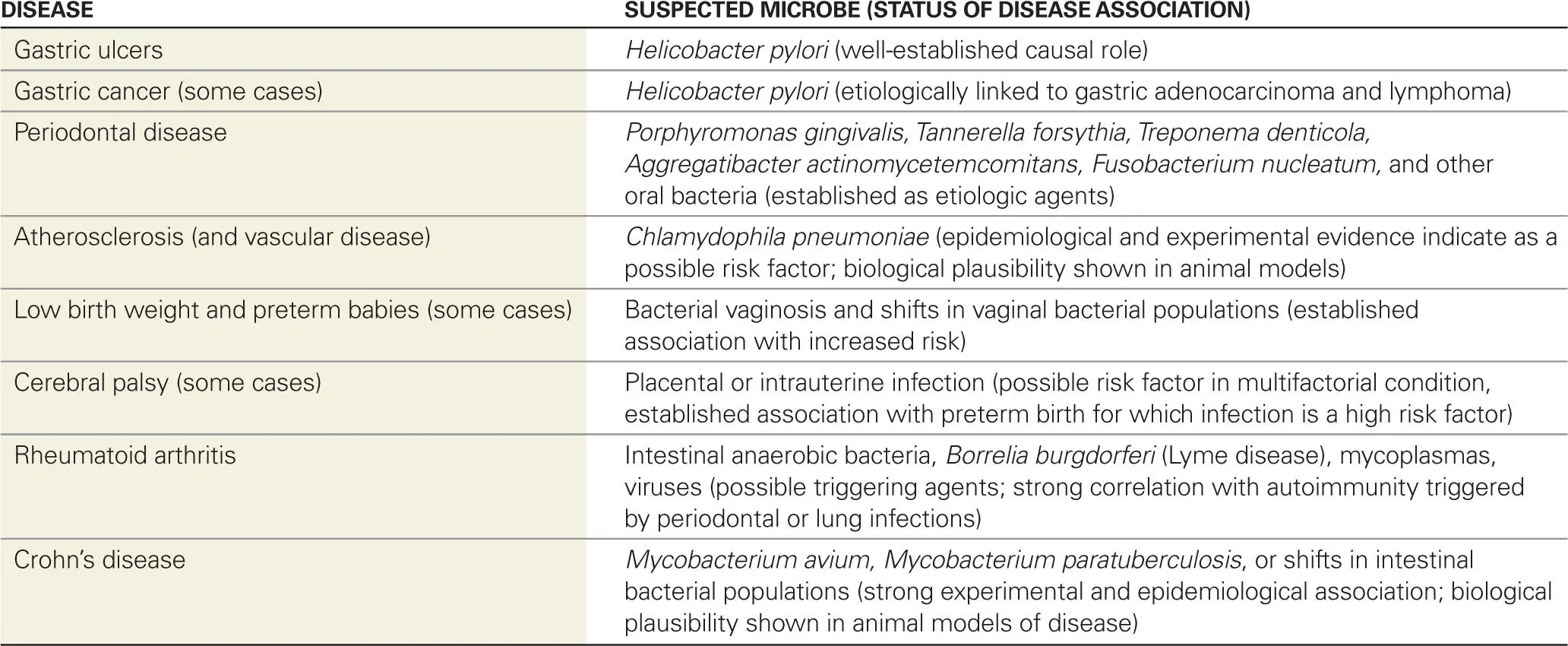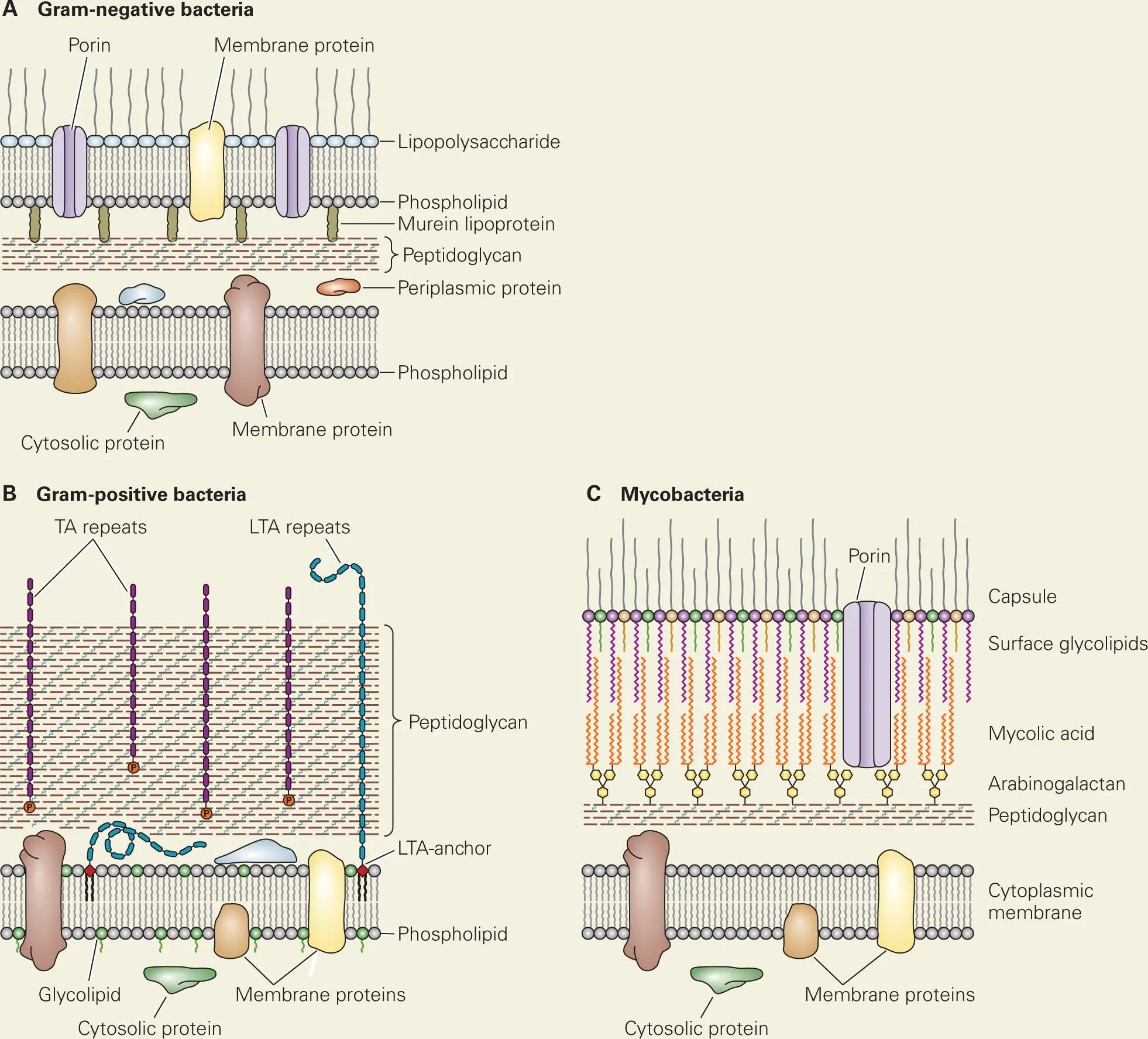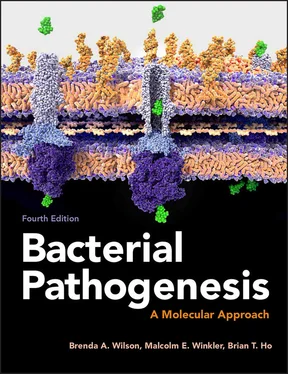A partial list of the diseases currently being reexamined for possible bacterial origins is provided in Table 1-1. The scope of this list conveys better than anything else the boundless optimism that surged through the medical community once the implications of H. pylori as a cause of ulcers were fully appreciated. Table 1-1indicates that some of these causal associations are well-established, whereas others are still controversial and may not pan out as a direct cause. Yet if even a few of these diseases become curable due to having bacterial origins, a treatment revolution will have occurred. More details about some of these associations will be given in subsequent chapters. It is striking how rapidly great skepticism (about H. pylori as a cause of ulcers) metamorphosed into great optimism about the likelihood of making further discoveries of similar magnitude.
Table 1-1. Some diseases currently suspected of being caused by bacteria

Microbiota Shift Diseases
A category of bacterial disease that defies conventional classification consists of diseases that are not caused by a single bacterial pathogen, but rather by a shift in the composition of a bacterial population of some part of the human body. Although the natural microbial populations (microbiota, formerly called microflora) of the human body are usually protective, certain shifts in the composition of these populations can have pathological consequences. Diseases of this type are referred to as microbiota shift diseases. In chapter 5, “The Normal Human Microbiota,” examples of microbiota shift diseases are described in more detail, but for present purposes, one example should suffice: bacterial vaginosis.
Bacterial vaginosis is the term used to describe a shift in the vaginal microbiota from a predominantly Gram-positive population, dominated by Lactobacillus species, to a population of Gram-negative anaerobes. For a long time, this condition was not taken seriously by physicians because the only symptoms, if there were symptoms at all, were a sparse discharge, some discomfort, and in some women a fishy odor. Two papers in the New England Journal of Medicine in 1995 changed the status of bacterial vaginosis. One of these papers linked bacterial vaginosis with preterm births. This was an epidemiological association, not proof of a cause-and-effect relationship. The second paper described the result of an intervention study, in which antibiotics known to target Gram-negative anaerobes were administered to pregnant women with bacterial vaginosis, and the effect on the birth weight of the infant was determined. Antibiotic intervention that returned the vaginal microbiota to “normal” was associated with normal full-term births, whereas untreated women were significantly more likely to have preterm infants.
Soon after these first connections were made, bacterial vaginosis was linked to a higher risk of contracting HIV infections and other sexually transmitted diseases, just as chlamydial disease and gonorrhea had been shown previously. A major challenge for scientists trained in the analysis of diseases caused by a single species of microorganism is to learn how to deal technically and conceptually with polymicrobial diseases caused by shifts in bacterial populations consisting of hundreds of species. Undoubtedly, all of the species present are not equal contributors to the disease state, but the situation is far more complex than single-microbe infections.
A Brave New World of Pathogenesis Research
The H. pylori revolution captured the public imagination, but an even more important revolution has been the realization by research scientists that new molecular technologies are opening up a plethora of new opportunities to understand at the molecular level how infectious diseases develop. For several decades after the discovery of antibiotics, during a period in which a number of new vaccines were developed, it seemed sufficient to simply treat or prevent bacterial diseases. As long as antibiotics worked and vaccines were widely available, controlling bacterial infections at the practical level did not require in-depth information about the bacterium-host interaction. As physicians and scientists became concerned about increasing antibiotic resistance, there was a growing realization that a better understanding of the detailed interactions between the human body and the bacterial pathogen might lead to new treatment strategies.
Additionally, there was recognition that there are some diseases whose symptoms are caused by bacterially produced toxins that are not effectively treated by antibiotics. A good example is anthrax, a disease caused by Bacillus anthracis. The symptoms of this disease are caused by a protein toxin, produced and secreted as the bacteria multiply in the body. If the disease is diagnosed immediately and the right antibiotic is administered, the disease can be controlled. However, antibiotics do not inactivate the toxin, and if antibiotic therapy is delayed for even a few days, enough anthrax toxin will have been produced to cause death.
In the case of a disease called septic shock that develops when bacteria enter and proliferate in the bloodstream (sepsis), a nonprotein component of the Gram-negative bacterial cell surface, lipopolysaccharide (LPS) (see Box 1-4), acts as a toxin that leads to organ damage and death. Here too, antibiotics are only effective if they are administered very early in the infection before the bacteria lyse and release too much of this toxic material. Although anthrax is not a significant threat (other than as a potential bioweapon), septic shock continues to kill tens of thousands of people each year in the United States alone. As discussed in later chapters, new understanding has recently emerged about how the human body responds to LPS, as well as to nonprotein surface components of Gram-positive bacteria, such as lipoteichoic acid (LTA). There is growing hope that this knowledge will make possible new and more effective therapies.
Box 1-4.
A Brief Review of the Surfaces of Gram-Negative and Gram-Positive Bacteria—One Membrane versus Two
For convenience, bacteria are often divided into two main groups, Gram positive and Gram negative, based on their ability to retain a purple dye after being washed with organic solvent such as methanol or acetone (this procedure of coloring bacteria is called Gram staining). The LPS is located at the surface of Gram-negative cells and is composed of lipid A (composed of fatty acids and a disaccharide), the core oligosaccharide, and the repeating-unit O-antigen polysaccharide (panel A). The LPS forms the surface of the outer membrane, whose inner layer is composed of phospholipids. The thin peptidoglycan (also called murein) of Gram-negative species is located in the periplasm between the inner and outer membrane.

In contrast, the cell wall of Gram-positive species lacks LPS and an outer membrane (panel B). The thick peptidoglycan is composed of multiple, cross–linked layers. A substantial amount of the Gram-positive cell wall is made up of another anionic polymer called wall teichoic acid (WTA, or TA) and lipoteichoic acid (LTA), both of which contain repeat units of ribitol or glycerol phosphate linked to amino sugars, sometimes to amino acids, such as D-alanine, and sometimes to ternary amines, such as phosphorylcholine. TA is covalently bonded to the peptidoglycan, whereas LTA is linked to a lipid anchor in the cellular membrane.
Читать дальше














